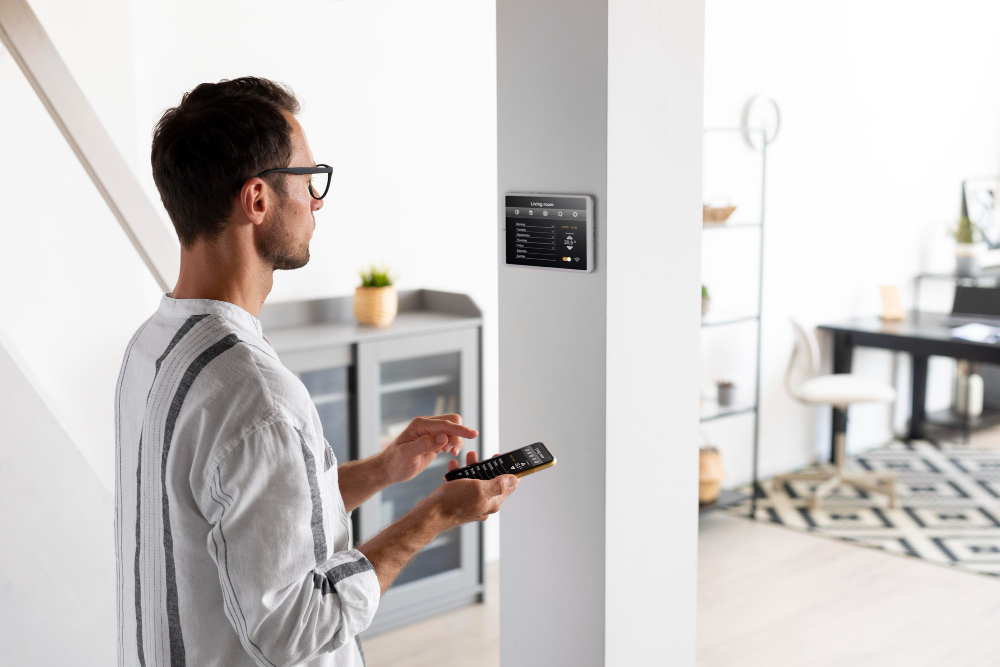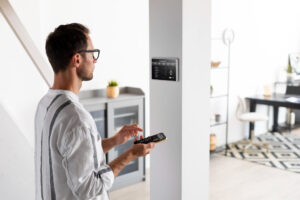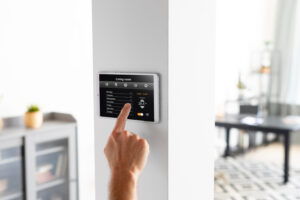Smart Home Security: Integrating Protection with Home Automation
The convergence of home security and smart home automation represents one of the most significant advancements in residential protection technology. Today’s integrated systems offer unprecedented control, convenience, and peace of mind by connecting security functions with everyday home management. This comprehensive guide explores how smart home security integration can enhance both your home’s protection and your quality of life.
The Evolution of Home Security Technology
Home security has undergone a remarkable transformation in recent years:
Traditional Security Systems
Conventional security systems typically operated as standalone solutions focused solely on intrusion detection. These systems generally included:
– Basic door and window sensors
– Motion detectors with limited functionality
– Hardwired connections with minimal flexibility
– Simple alarm functions with little user control
– Separate management from other home systems
The Smart Security Revolution
Modern smart security systems have transcended these limitations through:
– Integration with broader home automation platforms
– Advanced sensors with multiple functions
– Wireless technology enabling flexible installation
– Mobile control and monitoring capabilities
– Intelligent automation and scenario-based responses
This evolution has transformed security from an isolated function to an integral part of a comprehensive home management system.
Core Components of Integrated Smart Home Security
Smart Security Hubs and Controllers
The central brain of an integrated system coordinates all connected devices:
– Manages communication between security and automation devices
– Processes sensor inputs and triggers appropriate responses
– Enables customized automation scenarios and rules
– Provides user interface for system control
– Facilitates software updates and system expansion
Advanced Sensor Technology
Modern sensors do much more than detect intrusions:
– Multi-function sensors detecting motion, temperature, and light
– Environmental monitors for smoke, carbon monoxide, and water leaks
– Occupancy sensors that track presence in different rooms
– Door/window sensors that report both security status and environmental data
– Glass break detectors with acoustic analysis capabilities
Smart Cameras and Video Doorbells
Visual monitoring devices have become increasingly sophisticated:
– HD cameras with night vision and wide viewing angles
– Intelligent analytics for person and object detection
– Two-way audio communication capabilities
– Motion zone customization to reduce false alerts
– Event-based recording and notification
– Facial recognition on advanced models
Smart Locks and Access Control
Keyless entry systems provide both security and convenience:
– Remote locking and unlocking via smartphone
– Temporary access codes for visitors and service providers
– Automatic locking based on schedules or triggers
– Integration with other security events and scenarios
– Activity logs tracking all entry and exit events
Connected Lighting Systems
Smart lighting plays a crucial role in integrated security:
– Automated lighting schedules to simulate occupancy
– Motion-triggered illumination of specific areas
– Security event responses using light as a deterrent
– Pathway lighting for safety and convenience
– Energy-efficient operation through automation rules
Benefits of Integrating Security with Home Automation
Enhanced Security Through Intelligent Responses
Integration enables coordinated security responses:
– Motion detection can trigger cameras, lights, and recording
– Amazon Alexa – Voice-controlled system that integrates with smart devices like lights, thermostats, and locks. Uses Alexa skills to customize automation (e.g., turning on lights when you say “Good morning”)
– Google Home – Similar to Alexa, it uses Google Assistant to control smart devices, create routines (e.g., dim lights at sunset), and integrate with Nest products for thermostat and camera control
– Apple HomeKit – A platform for controlling smart devices via Siri or the Home app. Supports automation like locking doors when you leave or adjusting lights based on time of day
– Samsung SmartThings – A hub that connects various smart devices (lights, sensors, appliances) for centralized control. Automations include turning off devices when you leave home
Convenience and Lifestyle Enhancement
Beyond security, integration delivers daily benefits:
– Single-app control of security and home functions
– Automated routines that handle multiple tasks simultaneously
– Voice control integration with popular assistants
– Remote management of your entire home
– Simplified daily routines through automation
Energy Efficiency and Cost Savings
Smart integration helps optimize resource usage:
– Automated thermostat adjustments based on occupancy
– Lighting control to eliminate waste
– HVAC optimization through occupancy patterns
– Early detection of water leaks preventing damage
– Smart plugs managing power to devices when not needed
Proactive Home Monitoring
Integrated systems enable preventative protection:
– Water leak sensors preventing costly damage
– Temperature anomaly detection identifying potential issues
– Early warning for environmental hazards
– Ongoing system health monitoring
– Maintenance alerts for critical components
Creating Powerful Security Automation Scenarios
“Away Mode” Protection
Comprehensive security when you’re not home:
– All entry points secured and monitored
– Interior motion detection activated
– Lights programmed to simulate occupancy
– Cameras set to record all detected motion
– Thermostat adjusted for energy efficiency
– Immediate notifications of any unusual activity
“Good Morning” Routine
Seamless transition from night security to day mode:
– Disarm interior motion detection
– Adjust lighting based on natural light levels
– Modify thermostat for daytime comfort
– Maintain perimeter security monitoring
– Provide activity summary from overnight
“Bedtime” Security
Enhanced protection while you sleep:
– Verify all external doors and windows are secured
– Activate perimeter security while disabling interior motion detection
– Adjust lighting for nighttime safety
– Ensure cameras are actively monitoring critical areas
– Set thermostat for comfortable sleeping temperature
“Vacation” Mode
Extended absence protection:
– Advanced occupancy simulation with varied patterns
– Full recording of all detected events
– Regular system status reports
– Environmental monitoring with alert thresholds
– Water systems monitored for leaks or bursts
Implementation Considerations
Selecting Compatible Platforms and Devices
Creating a cohesive system requires careful planning:
– Choose devices that support common integration standards
– Consider future expansion when selecting a platform
– Verify compatibility between security and automation components
– Research integration capabilities with existing devices
– Prioritize security-focused platforms for critical functions
Professional vs. DIY Installation
While many smart devices advertise simple setup, professional installation offers significant advantages for integrated systems:
– Expert assessment of security vulnerabilities
– Optimal placement of sensors and cameras
– Proper integration between multiple systems
– Network configuration for reliable operation
– Creation of customized automation scenarios
– Thorough testing of all integrated functions
– Comprehensive training on system operation
Network Security Considerations
Connected security systems require proper cybersecurity measures:
– Secure WiFi networks with strong encryption
– Regular firmware updates for all connected devices
– Strong, unique passwords for system access
– Two-factor authentication when available
– Segmented networks for security devices when possible
Scalability and Future Expansion
Your security and automation needs will evolve over time:
– Select systems that allow for modular expansion
– Consider future technology compatibility
– Choose platforms with strong manufacturer support
– Plan for additional device integration
– Ensure your network infrastructure can scale
Conclusion: The Future of Home Protection
The integration of security and home automation represents the future of residential protection—a comprehensive approach that enhances both safety and lifestyle. By connecting these previously separate systems, homeowners gain unprecedented control, awareness, and peace of mind.
As smart home technology continues to advance, we can expect even more sophisticated integration, with artificial intelligence playing an increasing role in analyzing patterns, predicting needs, and responding to potential threats before they materialize.
At SoldiscInc, we specialize in designing and installing custom integrated security and automation systems that protect what matters most while enhancing your daily life. Our security experts can assess your home, understand your priorities, and create a seamless solution that provides both protection and convenience.
Ready to transform your home with integrated smart security? Contact SoldiscInc today at +1(204) – 891 – 5326 or request a free smart home security consultation to discover the perfect solution for your needs.




